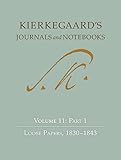Kierkegaard's Journals and Notebooks, Volume 11, Part 2 : Loose Papers, 1843-1855 / Søren Kierkegaard; ed. by David D. Possen, Vanessa Rumble, Bruce H. Kirmmse, Alastair Hannay, Niels Jørgen Cappelørn, Joel Rasmussen.
Material type: TextSeries: Kierkegaard's Journals and Notebooks ; 17Publisher: Princeton, NJ : Princeton University Press, [2020]Copyright date: ©2020Description: 1 online resource (784 p.)Content type:
TextSeries: Kierkegaard's Journals and Notebooks ; 17Publisher: Princeton, NJ : Princeton University Press, [2020]Copyright date: ©2020Description: 1 online resource (784 p.)Content type: - 9780691197302
- 9780691204826
- Philosophers -- Denmark -- Diaries
- PHILOSOPHY / History & Surveys / Modern
- Danish philosopher
- Kierkegaard in English
- Kierkegaard
- collected papers
- collected works
- complete works
- diaries
- final writings of Kierkegaard
- last writings of Kierkegaard
- nineteenth century philosophers
- philosopher
- previously unpublished
- published for the first time in English
- scholarly edition
- uncollected papers
- uncollected writings
- unpublished writings
- 198.9 22
- B4372 .K54112 2020
- online - DeGruyter
| Item type | Current library | Call number | URL | Status | Notes | Barcode | |
|---|---|---|---|---|---|---|---|
 eBook
eBook
|
Biblioteca "Angelicum" Pont. Univ. S.Tommaso d'Aquino Nuvola online | online - DeGruyter (Browse shelf(Opens below)) | Online access | Not for loan (Accesso limitato) | Accesso per gli utenti autorizzati / Access for authorized users | (dgr)9780691204826 |
Browsing Biblioteca "Angelicum" Pont. Univ. S.Tommaso d'Aquino shelves, Shelving location: Nuvola online Close shelf browser (Hides shelf browser)

|

|

|

|

|

|

|
||
| online - DeGruyter A Joyfully Serious Man : The Life of Robert Bellah / | online - DeGruyter Western Europe’s Democratic Age : 1945–1968 / | online - DeGruyter A Lot of People Are Saying : The New Conspiracism and the Assault on Democracy / | online - DeGruyter Kierkegaard's Journals and Notebooks, Volume 11, Part 2 : Loose Papers, 1843-1855 / | online - DeGruyter Modern Architecture and Climate : Design before Air Conditioning / | online - DeGruyter Prototype Nation : China and the Contested Promise of Innovation / | online - DeGruyter Sharing Responsibility : The History and Future of Protection from Atrocities / |
Frontmatter -- CONTENTS -- Kierkegaard’s Journals and Notebooks. Introduction to the English Language Edition -- Introduction to the Loose Papers -- LOOSE PAPERS, 1843–1852 -- Paper 305–Paper 446 -- LOOSE PAPERS, 1852–1855 -- PAPER 447—PAPER 468 -- Notes for PAPER 305–PAPER 446 -- Notes for PAPER 305–PAPER 446 -- MAPS -- CALENDAR -- CONCORDANCE
restricted access online access with authorization star
http://purl.org/coar/access_right/c_16ec
For over a century, the Danish thinker Søren Kierkegaard (1813–55) has been at the center of a number of important discussions, concerning not only philosophy and theology, but also, more recently, fields such as social thought, psychology, and contemporary aesthetics, especially literary theory.Despite his relatively short life, Kierkegaard was an extraordinarily prolific writer, as attested to by the 26-volume Princeton University Press edition of all of his published writings. But Kierkegaard left behind nearly as much unpublished writing, most of which consists of what are called his "journals and notebooks." Kierkegaard has long been recognized as one of history's great journal keepers, but only rather small portions of his journals and notebooks are what we usually understand by the term "diaries." By far the greater part of Kierkegaard's journals and notebooks consists of reflections on a myriad of subjects—philosophical, religious, political, personal. Studying his journals and notebooks takes us into his workshop, where we can see his entire universe of thought. We can witness the genesis of his published works, to be sure—but we can also see whole galaxies of concepts, new insights, and fragments, large and small, of partially (or almost entirely) completed but unpublished works. Kierkegaard's Journals and Notebooks enables us to see the thinker in dialogue with his times and with himself.Kierkegaard wrote his journals in a two-column format, one for his initial entries and the second for the extensive marginal comments that he added later. This edition of the journals reproduces this format, includes several photographs of original manuscript pages, and contains extensive scholarly commentary on the various entries and on the history of the manuscripts being reproduced.Volume 11, Parts 1 and 2, present an exciting, enlightening, and enormously varied treasure trove of papers that were found, carefully sorted and stored by Kierkegaard himself, in his apartment after his death. These papers—many of which have never before been published in English—provide a window into many different aspects of Kierkegaard's life and creativity. Volume 11, Part 2, includes writings from the period between 1843, the year in which he published his breakthrough Either/Or, and late September 1855, a few weeks before his death, when he recorded his final reflections on "Christendom." Among the highlights are Kierkegaard's famous description of the "Great Earthquake" that shaped his life; his early reflections on becoming an author; his important, though never-delivered, lectures on "The Dialectic of Ethical and Ethical-Religious Communication"; and his final, incandescent assault on the tendency—new in his time—to harness Christianity in support of a specific social and political order.
Mode of access: Internet via World Wide Web.
In English.
Description based on online resource; title from PDF title page (publisher's Web site, viewed 27. Jan 2023)


